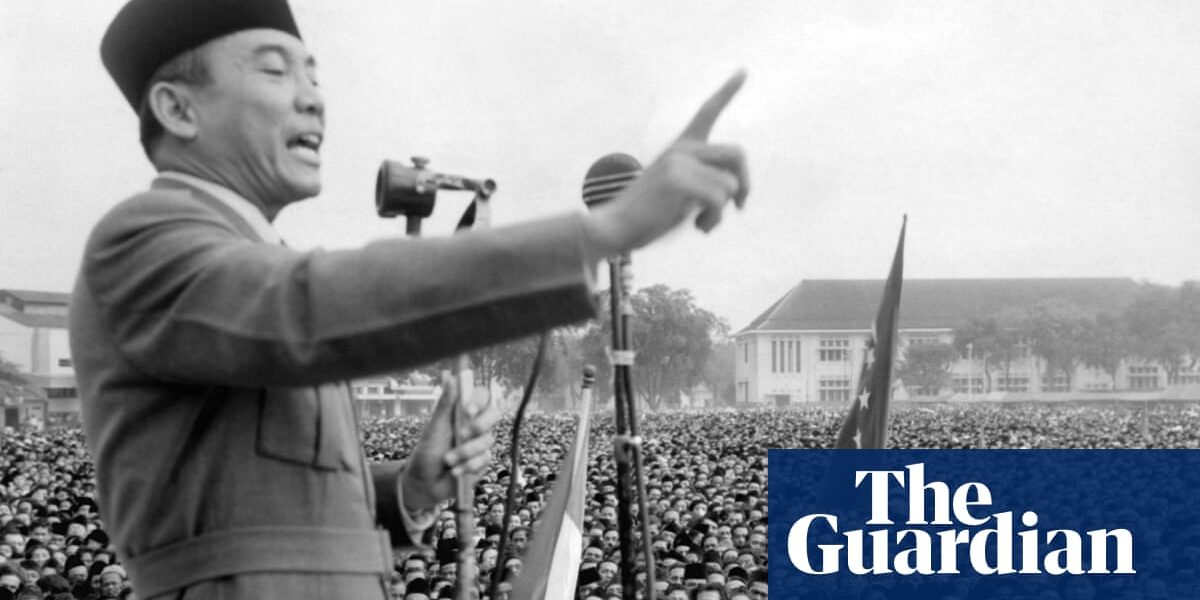This is a review of “Revolusi” by David Van Reybrouck, which discusses Indonesia’s struggle for independence.

I
Indonesia is the biggest island nation in the world, with 17,000 land masses emerging from the junction of the Indian and Pacific oceans. These islands vary greatly in size, from the immense Sumatra, Java, and Borneo to the small volcanic formations in the Banda Sea. With a population of 280 million, Indonesia is the fourth most populous country on the planet, following India, China, and the US. It is also the largest country with a Muslim majority. However, it tends to be disregarded by Westerners. How many English speakers could even locate Jakarta on a map? Telling the story of this country is a colossal undertaking that requires extensive research. This is precisely what Belgian historian David Van Reybrouck has accomplished in his remarkable book, Revolusi.
In pre-history, hunter-gatherers were the first humans to reach the archipelago 75,000 years ago. Later, around 2000BC, a group known as the Austronesians, who were highly skilled seafarers, arrived and spread across the oceans from Madagascar to Hawaii. Due to their strategic location, the Indonesian islands were influenced by civilizations and religions from the north and west. Brahminism and Hinduism came from India while Buddhism and Taoism came from China. However, it was Islam, which arrived in the 13th century, that became the dominant religion in the archipelago.
Europeans were introduced to the exotic flavors of the “East Indies,” such as pepper, nutmeg, cardamom, cloves, and cinnamon, which were highly sought after in Flemish markets. However, it took Portuguese sailors many years to discover a direct route to the Indies through the Cape of Good Hope. In 1596, the first Dutch expedition led by Cornelis de Houtman of Gouda successfully reached Java and brought back a valuable cargo of spices. This led to the creation of the Dutch East India Company in 1602, which was granted a monopoly on trading in the east by the Netherlands confederation. Similar to the British East India Company founded two years earlier, the VOC had the power of a nation state and engaged in activities such as making treaties, constructing forts, and raising armies. In 1619, the VOC established its headquarters in Jakarta, formerly known as Batavia, which was named after the ancestral tribe of the Dutch. The main goal of the company was to generate profits for its investors. As Reybrouck points out, this plan ultimately had no chance of success.
The familiar tale of colonial avarice is evident in the actions of the British, French, and Belgian empires across the globe. The original mercantile venture evolved into a territorial conquest as the VOC claimed vast areas of land known for their production of spices. Land exchanges occurred with other colonizers, such as the trade of swampy Manhattan for the more valuable British-controlled island of Run, which was a major source of nutmeg. In other instances, the VOC used force to acquire territory and brutally punished those who opposed them. In the early 19th century, when Napoleon took over the Netherlands, the British invaded Java and appointed Thomas Stamford Raffles as governor. However, after Napoleon’s defeat, the British returned control of the islands to the new Dutch monarch, William I. William imposed strict control and by the 1850s, the East Indies accounted for over a third of the Dutch kingdom’s revenue. Despite this, it was not enough and over the next 50 years, through the efforts of the Royal Netherlands Indies Army, the Dutch conquered the remaining islands in the archipelago. By 1914, this small country with a population of less than 6 million ruled over a massive empire, including 40 million people in the Dutch East Indies.
How was life in this place? Reybrouck describes it as a nightmare-like colonial ship, where passengers are separated based on Dutch-imposed racial categories of “European,” “foreign oriental,” and “native.” The upper class enjoyed luxury, but for the majority, the social hierarchy was racist, inflexible, and degrading. In the 1920s, the most prominent figure challenging the status quo was Sukarno, the son of a Javanese teacher from the lower nobility. He would unite the three ideologies of nationalism, Marxism, and Islam into a powerful movement for independence, using the term “Indonesia” coined by a 19th-century British traveler in the region.
During the time of Indonesian independence, the Dutch consistently opposed it, but the second world war gave Sukarno added motivation for revolution and ultimately, independence. While the Germans had occupied the mainland during the war, Japan had taken control of the archipelago and encouraged the idea of decolonisation through their creation of a militant Indonesian youth group called the pemuda. In August 1945, after Japan surrendered and no allied force had arrived to “liberate” Indonesia, Sukarno declared independence.
The next five years were among the most violent in the history of the region. The Dutch government after the war prioritized reclaiming their financial assets and broke agreements made by their own negotiators. Few individuals, aside from Sukarno, are viewed positively during this time. The British and Americans supported Dutch neocolonial aggression, and the pemuda carried out brutal acts of violence. However, most blame is placed on Dutch politicians, administrators, and military officials who used torture and murder to regain control.
In this passage, Reybrouck introduces us to Captain Raymond Westerling, the commander of a Dutch unit known as the Special Troops Depot. His task was to suppress a rebellion in southern Sulawesi with a small group of soldiers. To do this, he developed the “Westerling method”, which involved arriving at a village before sunrise, gathering the residents in the central square, and searching their homes for any evidence of suspicious behavior. This could be something as small as owning a torch or a green T-shirt. Westerling would then announce his list of suspects to the village and force them to squat before executing them by shooting them in the head. Some villagers were selected for interrogation, and if they refused to betray their friends and family, Westerling would torture them by shooting them in various body parts before moving on to the next victim.
After the massacre, the village would be set on fire. This was approved by Westerling’s superiors and other Dutch officers were urged to imitate his actions. Westerling faced no consequences for his wrongdoing and spent the 1960s as a lifeguard at a pool in Holland, entertaining swimmers with his tales.
Ignore the advertisement for the newsletter.
after newsletter promotion
Despite the Dutch colonial troops resorting to violence, summary executions, systematic rape, and torture, they were unable to halt the progression of history. The UN Security Council, with the leadership of the US, was ultimately compelled to demand that the Dutch relinquish sovereignty by 1950 due to their shameful actions. Sukarno was freed from prison and on December 27, 1949, he traveled to Jakarta where he delivered a victorious speech on the governor-general’s palace steps. This marked the long-awaited achievement of Indonesian ownership over their own country.
One politician in The Hague expressed shame over his government’s treatment of the islands it had relied on for a long time. Social Democrat MP Jacques de Kadt wrote, “We are now seen as tyrants and deceivers to the rest of the world.” He believed that the opportunity for cooperation between two independent states in 1945 was ruined by local politicians from all Dutch parties. He concluded that all that remained was the realization of their mistakes and the feeling of shame for their narrow-mindedness, incompetence, and arrogance.
Source: theguardian.com


